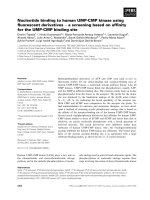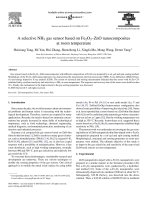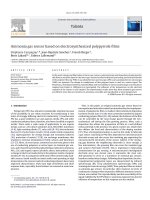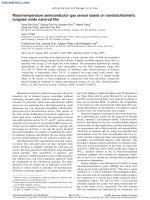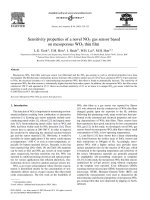Label free electrochemical immunoaffinity sensor based on impedimetric method for pesticide detection
Bạn đang xem bản rút gọn của tài liệu. Xem và tải ngay bản đầy đủ của tài liệu tại đây (503.54 KB, 7 trang )
Label-Free Electrochemical Immunoaffinity Sensor Based on
Impedimetric Method for Pesticide Detection
H. V. Tran,
a
S. Reisberg,
a
B. Piro,*
a
T. D. Nguyen,
b
M. C. Pham
a
a
Univ. Paris Diderot, Sorbonne Paris CitØ, ITODYS, UMR 7086 CNRS, 15 rue J-A de Baïf, 75205 Paris Cedex 13, France
tel: + 33-1-57277224
b
Institute for Tropical Technology (ITT), Vietnamese Academy of Science and Technology, 18 Hoang Quoc Viet, Hanoi, Vietnam
*e-mail:
Received: July 4, 2012
Accepted: October 10, 2012
Published online: January 24, 2013
Abstract
We present a new approach using a conducting polymer to combine immunoaffinity and electrochemical impedance
spectroscopy for atrazine detection. The system is based on a competitive complexation between anti-atrazine anti-
body and either atrazine present in the analyzed sample or hydroxyatrazine immobilized on the sensor surface. The
process allows to detect atrazine at a very low detection limit (0.2 ngL
À1
) in a true label-free format (no redox
probe added in solution) by following changes in the electrochemical impedance of the sensor.
Keywords: Conducting polymers, Electrochemical impedance spectroscopy (EIS), Enzyme-linked immunosorbent
assays (ELISA), Immunosensors, Label-free detection, Cross-reactivity, Atrazine, Pesticides
DOI: 10.1002/elan.201200331
1 Introduction
The increased use of pesticides and herbicides has led to
serious problems of contamination of soil and water. The
maximum value for atrazine in drinkable water set by the
World Health Organization is 2 mgL
À1
, and this limit is
even lower in the European Union (0.1 mgL
À1
). Given
this, atrazine has been often chosen as a model to develop
analytical devices.
Immunoassay technology with enzyme-linked immuno-
sorbent assays (ELISA) is now seen as a gold-standard of
immunoassays for pesticide analysis. The immunoassays
kits are inexpensive, simple, adaptable to field use and
constitute a rapid way to determine contaminants in envi-
ronmental samples [1,2]. ELISA test is based on anti-
body technology and involves the immobilization of a re-
actant (an antibody, an antigen or a part of an antigen,
called hapten) onto a solid surface with enzymes being
used as markers for the presence of a specific antibody-
antigen (Ab/Ag) or antibody-hapten (Ab/Hp) complex.
However, ELISA tests are not efficient for simultaneous
multiple analysis (multiplexing), continuous detection and
transduction into an electronically processable signal.
Conversely, label-free electrochemical immunosensors are
efficient for these tasks [3,4]. Among them, impedimetric
immunosensors are the subject of special attention [5–7].
Electrochemical Impedance Spectroscopy (EIS) consti-
tutes an efficient way to follow the Ab/Ag or Ab/Hp in-
teractions at electrode surfaces, by probing changes in ion
diffusion and electrical capacitance [8]. In the last five
years, the applications of EIS to the detection of small an-
tigenic organic pollutants, as bisphenol A [9], organic
toxins [10,11] or pesticides, mainly atrazine [7,12,13]
have shown growing interest. Hleli et al. reported a detec-
tion limit of 20 ngmL
À1
atrazine using an impedimetric
immunosensor based on mixed biotinylated self-assem-
bled monolayer [14]. Later, Cosnier et al. reported the
detection of extremely low atrazine concentration
(10 pgmL
À1
) using a label-free impedimetric immunosen-
sor based on a conducting polymer cleverly modified to
bind the antibody probe using affinity interactions [7].
They showed that the immunoreaction of atrazine on the
attached anti-atrazine antibody induces an increase in the
charge transfer resistance proportional to the atrazine
concentration.
Among the key steps in the design of an immunosen-
sor, the immobilization of the bioreceptor is decisive. The
introduction of appropriate functionalities through chemi-
cal modification of a monomer can provide polymer films
with specific characteristics. Conducting polymers such as
polypyrrole or polyaniline have been extensively studied
for their great functionalization potentialities and advan-
tageous electrochemical properties [15–18]. Polyquinone
derivatives are less investigated but, nevertheless, present
great and remarkable electrochemical properties as well
as good biocompatibility, easy bio-functionalization and
a very stable electroactivity in neutral aqueous medium
[19]. These properties can be used to probe biomolecular
interactions [20–24] due to the high sensitivity of the qui-
none group to its local physico-chemical environment.
TOPICAL CLUSTER
664 2013 Wiley-VCH Verlag GmbH&Co. KGaA, Weinheim Electroanalysis 2013, 25, No. 3, 664– 670
Full Paper
In the present study, we describe an innovative strategy
based on an original electrogenerated polyquinone film
functionalized by a hydroxyatrazine moiety (HATZ) for
sensitive and direct detection of atrazine (ATZ). The syn-
thesized monomer [N-(6-(4-hydroxy-6-isopropylamino-
1,3,5-triazin-2-ylamino)hexyl)-5-hydroxy-1,4-naphthoqui-
none-3-propionamide] (JUG-HATZ) contains three func-
tional groups: the hydroxyl group for electropolymeriza-
tion, the quinone group to be used as transducer, and hy-
droxyatrazine (a structural analogue of ATZ) as biore-
ceptor element (Scheme 1). Electropolymerization of
JUG-HATZ leads to poly[N-(6-(4-hydroxy-6-isopropyla-
mino-1,3,5-triazin-2-ylamino)hexyl)5-hydroxy-1,4-naph-
thoquinone-3-propionamide], poly(JUG-HATZ) [25]. By
this method, the quinone and the hydroxyatrazine func-
tions are preserved. We have shown that poly(JUG-
HATZ) is able to specifically bind a-ATZ, the antibody
directed to atrazine, due to cross-reactivity of a-ATZ for
HATZ. a-ATZ is eventually removed from the electrode
surface if ATZ (the natural ligand of a-ATZ) is present
in solution (see Figure 1). This architecture differs from
other devices used in label-free impedimetric imunosen-
sor, for which the antibody is immobilized on the surface.
In the present work, electrochemical impedance spectros-
copy (EIS) is used to identify the physico-chemical prop-
erties of the electrode/electrolyte interface (such as ca-
pacitances and charge transport resistances), which are
dramatically influenced by the antibody binding/unbind-
ing, Changes in these parameters are significant and can
be used individually to determine ATZ in solution, for
concentration as low as 0.2 pgmL
À1
.
2 Experimental
2.1 Chemicals
All reagents and solvents were PA type. Phosphate buffer
saline (PBS, 137 mM NaCl; 2.7 mM KCl; 8.1 mM
Na
2
HPO
4
; 1.47 mM KH
2
PO
4
, pH 7.4) was provided by
Sigma. Aqueous solutions were made with ultrapure
(18 MW cm) water. Glassy carbon electrodes (GC, 3 mm
in diameter, S= 0.07 cm
2
) were purchased from BASInc.
Anti-atrazine (a-ATZ) antibody (monoclonal) was pur-
chased from Thermo Scientific, USA. Atrazine (ATZ)
and atrazine-desethyl-2-hydroxy (ATD) were purchased
from Supelco (USA). 5-hydroxy-1,4-naphthoquinone
(JUG), 1-naphthol (1-NAP), lithium perchlorate
(LiClO
4
), acetonitrile (ACN) and ethanol (EtOH), practi-
cal grade, were from Sigma-Aldrich. Dry Argon (Ar) was
purchased from Air Liquide (France). N-(6-(4-hydroxy-6-
isopropylamino-1,3,5-triazin-2-ylamino)hexyl)-5-hydroxy-
1,4-naphthoquinone-2(3)-propionamide (JUG-HATZ)
and 5-hydroxy-3-thioacetic acid-1,4-naphthoquinone
(JUGA) were synthesized in the lab [21].
2.2 Preparation of the Poly(JUG-HATZ)-Modified
Electrodes
GC electrodes were polished by 1 mm alumina slurry then
sequentially washed in an ultrasonic bath with distilled
water, EtOH and ACN for 5 minutes. The electrochemi-
cal synthesis of the polymer films was carried out by elec-
trooxidation of 510
À3
M JUG-HATZ+10
À3
M 1-NAP+
0.1 M LiClO
4
in ACN on GC electrodes, under Ar, at
a constant potential of 1.25 V (vs. SCE) during 600 s.
After that, electrodes were repeatedly washed with aceto-
nitrile to remove residual monomers then put into an
electrochemical cell containing PBS and scanned between
À0.9 V and 0 V at a scan rate of 50 mVs
À1
under Ar at-
mosphere until complete stabilization of the voltammo-
grams. After this treatment, electrodes were characterized
by electrochemical impedance spectroscopy (EIS).
TOPICAL CLUSTER
Fig. 1. Schematic representation of the ion flux, before and
after complexation and decomplexation.
Electroanalysis 2013, 25, No. 3, 664 – 670 2013 Wiley-VCH Verlag GmbH&Co. KGaA, Weinheim www.electroanalysis.wiley-vch.de 665
Electrochemical Immunoaffinity Sensor for Pesticide Detection
2.3 Complexation of a-ATZ on Poly(JUG-HATZ)-
Modified Electrodes
Poly(JUG-HATZ)-modified electrodes were immersed
into PBS containing a-ATZ (the concentration of which
depends on the experiment) overnight at 378C to achieve
complexation between HATZ and a-ATZ. After that, the
electrodes were rinsed thrice with ultrapure water and
immersed into PBS for 1 h at 37 8C to remove nonspecifi-
cally adsorbed a-ATZ. After this step, electrodes were
characterized by EIS. Such electrodes are referred as
poly(JUG-HATZ)/a-ATZ. The maximum surface concen-
tration of a-ATZ is ca. 0.2 pmolcm
À2
, i.e. 10
9
antibodies
on an electrode area of 0.07 cm
2
.
2.4 Detection of ATZ
For ATZ detection, poly(JUG-HATZ)/a-ATZ electrodes
were dipped 2 h at 378C into a 100 mL sample of water
containing ATZ at concentrations between 0.1 pM and
0.1 mM, then washed with PBS at 378C for 30 min. After
that, electrodes were characterized by EIS.
2.5 Methods
EIS was performed using an Autolab PGSTAT30
equipped with the FRA module. Impedance spectra were
recorded in PBS buffer at room temperature at a given
potential within a frequency range from 10 kHz to
100 mHz with a perturbation amplitude of 10 mV. As
a pretreatment before each experiment, a constant poten-
tial corresponding to the one used for EIS was imposed,
for 120 s. Solutions were systematically deaerated with Ar
before and during experiments.
3 Results and Discussion
3.1 JUG-HATZ Electroactivity
JUG, JUGA and JUG-HATZ were dissolved into PBS
buffer at a concentration of 0.1 mM. Their electroactivity
was investigated using cyclic voltammetry from À0.7 V to
0.1 V (vs. SCE) at a scan rate of 50 mVs
À1
using GC elec-
trodes. The results are showed on Figure 2. The redox
peaks (E
pa
/E
pc
) of JUG, JUGA and JUG-HATZ are situ-
ated at À0.27/À0.31 V; À0.28/À0.33 V and À0.29/À0.36 V
vs. SCE, respectively. Averaged peak potentials (E
1/2
) are
À0.29 V; À0.30 V and À0.33 V (vs. SCE), respectively.
Changes in potentials for JUGA and JUG-HATZ com-
pared to JUG reflect the presence of lateral chains of the
substituents, which are slightly electrodonors (so that the
reduction of the quinone moiety is slightly more difficult
and occurs at lower potentials). Changes in currents, for
the same concentration, reflect a decrease of the diffusion
coefficient for JUGA and JUG-HATZ compared to
JUG.
3.2 EIS on Poly(JUG-HATZ)-Modified Electrodes
Electroactivity of poly(JUG-HATZ)-modified electrodes
in PBS buffer is shown in Figure 3. Two main redox cou-
ples are present, centered at around À0.44/À0.53 V and
À0.72/À0.76 V vs. SCE. A third couple appears as should-
ers at À0.27/À0.30 V vs. SCE. This redox system is com-
parable to that of the monomer (Figure 2), with widened
peaks due to electronic delocalisation within the polymer
structure. In aqueous solution, quinones transfer two elec-
trons and two protons in a concerted process. As previ-
ously reported, we assume that the presence of three cou-
ples of peaks in PBS is due to three different types of qui-
TOPICAL CLUSTER
Fig. 2. Electroactivities of (a) JUG; (b) JUGA and (c) JUG-
HATZ. Concentration: 10
À4
M. Scan rate 50 mV s
À1
. Potential
range: À0.7 to 0.1 V (vs. SCE). Medium: PBS. GC electrode, S=
0.07 cm
2
.
Fig. 3. CV for poly(JUG-HATZ)-modified GCE in argon-satu-
rated solution of PBS (pH 7.4), scan rate 50 mVs
À1
. E=À0.9 to
0 V (vs. SCE).
666 www.electroanalysis.wiley-vch.de 2013 Wiley-VCH Verlag GmbH&Co. KGaA, Weinheim Electroanalysis 2013, 25, No. 3, 664 – 670
Full Paper H. V. Tran et al.
nones on the electrode surface: at the electrode/polymer
interface, in the bulk of the polymer and at the polymer/
electrolyte interface [20–25]. The electrochemical stability
of this modified electrode is excellent. It takes ca. 50 vol-
tammetric cycles to stabilize the system in PBS [25] then
it becomes perfectly stable (no measurable changes) for
more than 250 cycles, or several days of storage in PBS.
Electrochemical Impedance Spectroscopy (EIS) is an
efficient method to probe the interfacial properties of sur-
face-modified electrodes [26]. We performed EIS on
poly(JUG-HATZ)-modified electrodes in the same po-
tential domain than for cyclic voltammetry (Figure 4).
To fit the experimental spectra, the equivalent circuit
presented on Figure 5 was used. It includes R
f
, R
ef
and R
s
which are the resistances of the film, of the electrolyte-
film interface and of the electrolyte, respectively. The
constant phase elements represent the pseudocapacitan-
ces of the electrolyte-film interface (CPE
ef
) and of the
film (CPE
f
), respectively. In addition, we introduced an-
other constant phase element (CPE
d
) to characterize dif-
fusion of ions from the electrolyte bulk to the electrode,
which better fits experimental data than the classical War-
burg element [27].
The impedance of a CPE is expressed as
Z
CPE
¼ Q
À1
0
w
Àn
with n a corrective term between 1 (perfect capacitor)
and 0, and Q
0
= 1/jZj for n = 1andw=1 rad s
À1
. For our
fitting, values of n were kept between 0.8 and 1.
Values extracted from fittings (given on Figure 6) are
in good agreement with cyclic voltammetry (Figure 3):
diffusion (CPE
d
) appears to be maximal at around
À0.4 V, where the slope of the film capacitance (CPE
f
)is
the highest. The electrolyte-film capacitance (CPE
ef
)is
the lowest at À0.5 V, as well as the film resistance (R
f
).
These last three parameters are the most informative
about changes which can occur on the electrode surface
and can be used to characterize, at a given potential, anti-
body complexation or decomplexation.
3.3 ATZ Detection
It is noteworthy to recall the ability of the combining site
of an antibody to react with more than one antigenic de-
terminant. This is known as cross-reactivity and arises be-
cause the cross-reacting antigen shares a structure similar
to that of the immunizing antigen (here ATZ) used to
generate antibodies. The phenomenon of cross-reactivity
is an intrinsic characteristic of all antibodies but depends
also on the relative concentrations of cross-reactant. In
our case, the antibody a-ATZ generated from ATZ
(chlorinated s-triazine) can also bind to HATZ (the hy-
droxylated s-triazine), but with lower affinity [28–30]. We
took advantage of this cross-reactivity to design our sens-
ing strategy. As explained, poly(JUG-HATZ) is able to
bind to a-ATZ, which covers the electrolyte-film inter-
face. However, a-ATZ recognizes HATZ with less affini-
ty than for ATZ (which is the natural ligand of a-ATZ)
so that, when put into contact with ATZ, a-ATZ is re-
moved from the electrode surface (this is illustrated on
Figure 1).
We have demonstrated in previous studies that the
electroactivity of polyquinone-modified electrodes is sen-
sitive to changes in cation diffusion, sodium in particular
[19]. This can be generated by heavy molecules at the vi-
cinity of the film surface, influencing the diffusion layer
by steric hindrance. This is what occurs when a-ATZ is
present at the electrolyte-film interface. a-ATZ has a mo-
lecular weight of ca. 150 kDa and an hydrodynamic
volume of about 25 nm
3
, which makes a projected surface
of 25
2/3
=8.5 nm
2
, so that a-ATZ can strongly inhibits ion
exchange. Upon ATZ detection, the antibody is released
and the electrolyte-film interface is cleared, so that the
TOPICAL CLUSTER
Fig. 4. Nyquist plot obtained for a poly(JUG-HATZ)-modified
electrode at different formal DC potentials vs. SCE in 100 mM
PBS buffer solution, pH 7.4. Spectra are presented between
100 kHz to 1.265 Hz. Symbols correspond to experimental data
and lines correspond to fittings.
Fig. 5. Equivalent circuit used to fit experimental spectra. R
s
is
the solution resistance, R
ef
and CPE
ef
are the electrolyte-film in-
terface resistance and pseudocapacitance (CPE is a constant
phase element), R
f
and CPE
ef
are the film resistance and pseudo-
capacitance. For the CPE
ef
, values of n were kept between 0.9
and 1.
Electroanalysis 2013, 25, No. 3, 664 – 670 2013 Wiley-VCH Verlag GmbH&Co. KGaA, Weinheim www.electroanalysis.wiley-vch.de 667
Electrochemical Immunoaffinity Sensor for Pesticide Detection
film resistance R
f
associated to ion diffusion is expected
to decrease.
For the same reasons, a-ATZ decomplexation should
influence the film pseudocapacitance, CPE
f,
considering
that this pseudo-capacitance comes from ion diffusion.
The electrolyte-film interface pseudocapacitance CPE
ef
should also change when a-ATZ is removed, for a differ-
ent reason.
CPE
ef
is given by:
CPE
ef
¼ ee
0
=d
with e the relative permittivity of the medium, e
0
the per-
mittivity of vacuum and d the double layer thickness. The
antibody at the electrolyte-film interface does not change
the permittivity of the medium but due to steric hin-
drance, it significantly increases the double layer thick-
ness d. On the contrary, when the antibody is removed,
this double layer thickness decreases, so that CPE
ef
should increase. R
f
, CPE
f
and CPE
ef
are given as a func-
tion of ATZ concentration, on Figure 7. Values for R
f
,
CPE
f
and CPE
ef
before addition of ATZ are 1306 W,
1.05 mF and 0.12 mF, respectively (these values appear as
dashed lines on Figure 7). As shown, at an ATZ concen-
tration of 10
À13
M, changes for R
f
, CPE
f
and CPE
ef
are
not significant, due to the standard deviation. However,
for 10
À12
M, ca. 0.2 ngL
À1
, variations become significant.
This value can be considered as the limit of detection.
These variations are relatively linear (in a log scale) up to
10
À7
M (ca. 20 mgL
À1
), which covers practical concentra-
tions. Considering the size of a-ATZ, the maximum sur-
face concentration of a-ATZ is ca. 10
9
antibodies on an
electrode area of 0.07 cm
2
. This value is in accordance
with the lowest detectable quantity of ATZ which is 6
10
8
molecules (10
À12
M in 100 mL).
3.4 Selectivity
The transduction mechanism is based on the cross-reac-
tivity of a-ATZ towards HATZ. That is why it is impor-
tant to evaluate the selectivity of this sensor towards an-
other structural analogue of atrazine, for example 2-
TOPICAL CLUSTER
Fig. 6. Effect of the offset potential on the characteristics of poly(JUG-HATZ) modified electrode: (a) diffusion peudo-capacitance,
(b) film pseudo-capacitance, (c) electrolyte-film interfacial pseudo-capacitance, and (d) film resistance. Results obtained for offset po-
tentials between À0.8 V and 0 V vs. SCE, in PBS, fitted from the equivalent circuit of Figure 5 in the range of 100 kHz–1.265 Hz. For
the CPEs, values of n were kept between 0.8 and 1.
668 www.electroanalysis.wiley-vch.de 2013 Wiley-VCH Verlag GmbH&Co. KGaA, Weinheim Electroanalysis 2013, 25, No. 3, 664 – 670
Full Paper H. V. Tran et al.
amino-4-chloro-6-isopropylamino-1,3,5-triazine (desethy-
latrazine ATD, see Scheme 1).
Experiments were performed as described in Section
3.3, with ATD then with ATZ, at two different concentra-
tions: 1 nmolL
À1
and 10 nmolL
À1
. Relative changes in re-
sistance (R
f
), film capacitance (CPE
f
) and electrolyte-film
capacitance (CPE
ef
) are summarized and compared in
Table 1.
It appears that changes related to ATD are systemati-
cally and significantly lower than those related to ATZ.
For CPE
ef
, changes to ATD represents only 34% of the
one obtained for ATZ, at 10 nM ATD. As expected, the
selectivity is lower for high concentrations than for low
concentrations.
TOPICAL CLUSTER
Scheme 1. Chemical structures of atrazine (ATZ), its 2-hydroxy
analog (HATZ), its dealkylated derivative (ATD) and JUG-
HATZ.
Table 1. Relative changes in resistance (DR
f
), film capacitance
(DCPE
f
) and electrolyte-film capacitance (DCPE
ef
) as a function
of the target. DR
f
(%)=100 (R
a-ATZ
ÀR
a-ATZ/antigen
)/R
a-ATZ
; DCPE
f
(%)=100(CPE
fa-ATZ
ÀCPE
fa-ATZ/antigen
)/CPE
fa-ATZ
; DCPE
ef
(%)=100(CPE
efa-ATZ
ÀCPE
efa-ATZ/antigen
)/CPE
efa-ATZ
.
% DR
f
% DCPE
f
% DCPE
ef
ATZ ATD ATZ ATD ATZ ATD
1nM À24 À5 + 300 À70 + 170 +15
10 nM À26 À7 +320 + 100 + 230 + 90
Fig. 7. Changes in films resistance (R
f
); capacitance of conduc-
tive film (CPE
f
) and capacitance of film-electrolyte interface
(CPE
ef
) as function of the concentration of atrazine in solution
in the decomplexation step. Results obtained for an offset poten-
tial of À0.5 V vs.SCE, fitted from the the equivalent circuit of
Figure 5, in the range of 100 kHz–1.265 Hz. For the CPEs, values
of n were kept between 0.8 and 1. Values for R
f
, CPE
f
and CPE
ef
before addition of ATZ appear as dashed lines.
Electroanalysis 2013, 25, No. 3, 664 – 670 2013 Wiley-VCH Verlag GmbH&Co. KGaA, Weinheim www.electroanalysis.wiley-vch.de 669
Electrochemical Immunoaffinity Sensor for Pesticide Detection
4 Conclusions
We have shown that atrazine can be directly detected by
electrochemical impedance spectroscopy using a novel
multifunctional conducting polymer, poly(JUG-HATZ).
It acts both as the complexation and the transduction ele-
ment for a label-free, reagentless electrochemical immu-
nosensor. Experiments show that atrazine can be detected
down to ca. 1 pM (~0.2 pgmL
À1
), which is an excellent
result compared to similar immunosensors based on EIS
[7,10–13]. This was obtained when using an original
transduction scheme which takes profit from the cross-re-
activity of the antibody. The sensing sequence consists in:
1) immobilization of anti-ATZ antibodies on an electro-
active surface carrying an analogue of ATZ (HATZ); 2)
decomplexation of anti-ATZ by ATZ present in the ana-
lyzed solution, which triggers changes in several electro-
chemical impedance parameters such as the film resist-
ance, the film capacitance and the interfacial electrolyte-
film capacitance. This approach is versatile: it can be ex-
tended to other targets (pesticides, organic pollutants or
toxins) providing that they are antigenic. Works are in
progress with such molecules, e.g. bisphenol A, ochratox-
in and isoproturon.
References
[1] C. Mouvet, S. Broussard, R. Jeannot, C. Maciag, R. Abu-
knesha, G. Ismail, Anal. Chim. Acta. 1995, 311, 311.
[2] G. Xiong, J. Liang, S. Zou, Z. Zhang, Anal. Chim. Acta
1998, 371, 97.
[3] A. P. F. Turner, I. Karube, G. S. Wilson, Biosensors: Funda-
mentals and Applications. Oxford University Press. 1989.
[4] J. L. Marty, B. Leca, T. Noguer, Analusis 1998, 26, M144.
[5] E. Katz, I. Willner, Electroanalysis 2003, 15, 913.
[6] A. Ramanavicius, A. Finkelsteinas, H. Cesiulis, A. Ramana-
viciene, Bioelectrochemistry 2010, 79, 11.
[7] R. E. Ionescu, C. Gondran, L. Bouffier, N. Jaffrezic-Re-
nault, C. Martelet, S. Cosnier, Electrochim. Acta 2010, 55,
6228.
[8] A. Sargent, O. A. Sadik, Electrochim. Acta 1999, 44, 4667.
[9] M. A. Rahman, M. J.A. Shiddiky, J. S. Park, Y. B. Shim, Bio-
sens. Bioelectron. 2007, 22, 2464.
[10] A. E. Radia, X. Munoz-Berbel, V. Lates, J. L. Marty, Bio-
sens. Bioelectron. 2009, 24, 1888.
[11] A. Viga, A. Radoi, X. Munoz-Berbel, G. Gyemantc, J. L.
Marty, Sens. Actuators B 2009, 138, 214.
[12] E. Valera, J. Ramon-Azcon, A. Rodrıguez, L. M. Castaner,
F. J. Sanchez, M. P. Marco, Sens. Actuators B 2008, 129, 921.
[13] J. Ramon-Azcon, E. Valera, A. Rodrıguez, A. Barranco, B.
Alfaro, F. Sanchez-Baeza, M. P. Marco, Biosens. Bioelectron.
2008, 23, 1367.
[14] S. Hleli, C. Martelet, A. Abdelghani, N. Burais, N. Jaffrezic-
Renault, Sens. Actuators B 2006, 113, 711.
[15] S. Cosnier, Biosens. Bioelectron. 1999, 14, 443.
[16] M. Gerard, A. Chaubey, B. D. Malhotra,
Biosens. Bioelec-
trontron. 2002, 17, 345.
[17] S. Cosnier, Anal. Bioanal. Chem. 2003, 377, 507.
[18] S. Cosnier, M. Holzinger, Chem. Soc. Rev. 2011. 40, 2146.
[19] B. Piro, J. Haccoun, M. C. Pham, L. D. Tran, A. Rubin, H.
Perrot, C. Gabrieli, J. Electronal. Chem. 2005, 577, 155.
[20] S. Reisberg, D. F. Acevedo, A. Korovitch, B. Piro, V. Noel,
M. C. Pham, Talanta 2010, 80, 1318.
[21] B. Piro, A. Kapella, V. H. Le, G. Anquetin, Q. D. Zhang, S.
Reisberg, V. Noel, L. D. Tran, H. T. Duc, M. C. Pham, Elec-
trochim. Acta 2011, 56, 10688.
[22] Q. D. Zhang, G. March, V. Noel, B. Piro, S. Reisberg, L. D.
Tran, L. V. Hai, E. Abadia, P. E. Nielsen, C. Sola, M. C.
Pham, Biosens. Bioelectron. 2012, 32, 163.
[23] M. C. Pham, B. Piro, L. D. Tran, T. Ledoan, L. H. Dao,
Anal. Chem. 2003, 75, 6748.
[24] B. Piro, Q. D. Zhang, S. Reisberg, V. Noel, L. A. Dang,
H. T. Duc, M. C. Pham, Talanta 2010, 82, 608.
[25] H. V. Tran, S. Reisberg, B. Piro, N. Serradji, T. D. Nguyen,
L. D. Tran, C. Z. Dong, M. C. Pham, Biosens. Bioelectron.
2012, 31, 62.
[26] C. Gabrielli, O. Haas, H. Takenouti, J. Appl. Electrochem.
1987, 17, 82.
[27] J. Bisquert, G. Garcia-Belmonte, P. Bueno, E. Longo,
L. O. S. Bulhðes, J. Electroanal. Chem. 1998. 452, 229.
[28] J. M. Schlaeppi, W. Foery, K. Ramsteiner, J. Agric. Food
Chem. 1989, 37, 1532.
[29] M. Wortberg, G. B. Jonesb, S. Kreissig, D. M. Rocke, S. J.
Gee, B. D. Hammock, Anal. Chim. Acta 1996, 319, 291.
[30] K. Charlton, W. J. Harris, A. J. Porter, Biosens. Bioelectron.
2001, 16, 639.
TOPICAL CLUSTER
670 www.electroanalysis.wiley-vch.de 2013 Wiley-VCH Verlag GmbH&Co. KGaA, Weinheim Electroanalysis 2013, 25, No. 3, 664 – 670
Full Paper H. V. Tran et al.
